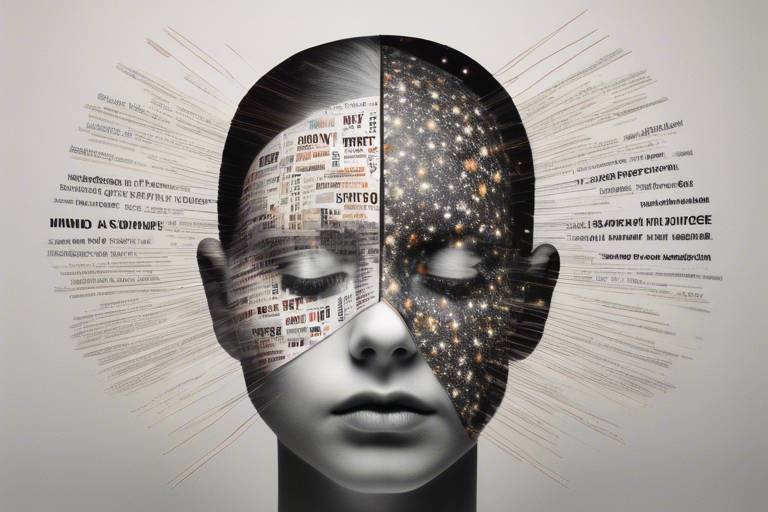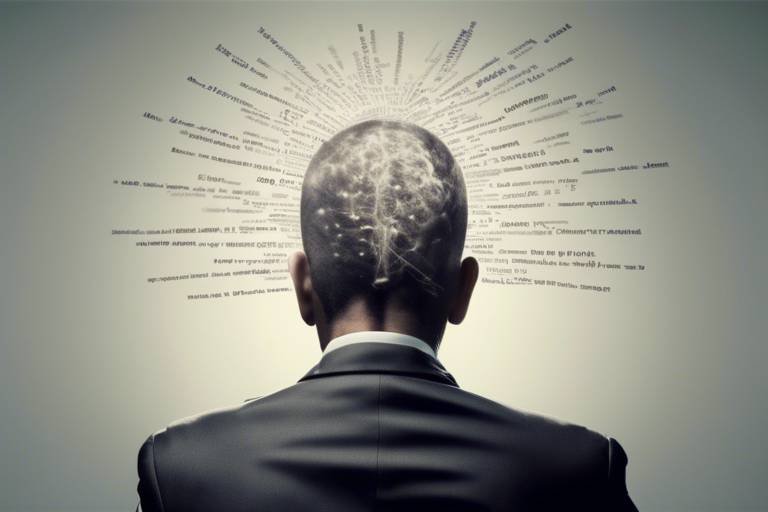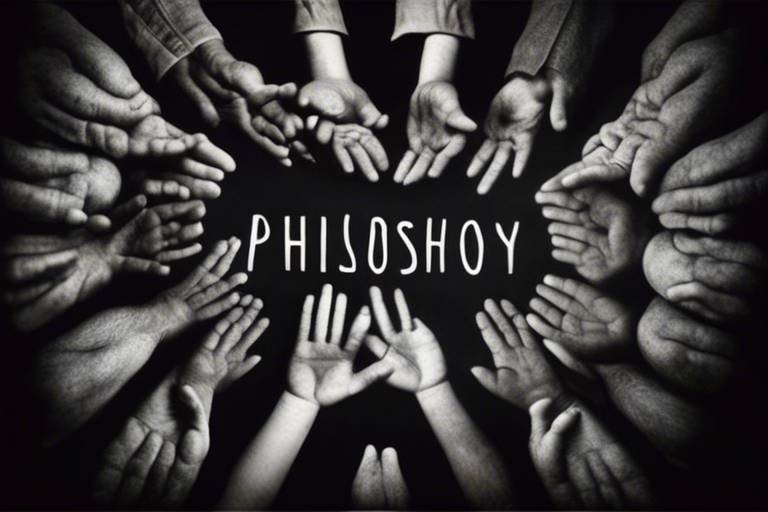The Mind as the Semiotic Universe
The intricate relationship between the mind and semiotics is a fascinating realm that invites us to explore how signs and symbols shape our understanding of reality. Imagine your mind as a vast universe, where every thought, feeling, and perception is a star, illuminating the dark expanse of the unknown. This article delves deep into the semiotic universe of the mind, revealing how the interplay of signs influences our cognitive processes and ultimately, our interpretation of the world around us.
At the core of this exploration is the concept of semiotics—the study of signs and symbols in communication. Think of semiotics as the grammar of our thoughts; it provides the rules and structures that allow us to make sense of our experiences. By understanding the fundamental principles of semiotics, we can better grasp how meaning is constructed and interpreted within our minds. Just as a painter uses colors to create a masterpiece, our minds use signs to construct our reality.
The mind's semiotic universe is not just a passive receiver of information; it actively engages with the signs it encounters. Each symbol is a doorway to a deeper understanding, a key that unlocks the potential for meaning. When we see a red traffic light, for instance, our minds instantly interpret it as a command to stop. This immediate recognition illustrates how deeply embedded signs are in our cognitive processes. They act as shortcuts, allowing us to navigate the complexities of life with relative ease.
As we journey further into this semiotic universe, we must consider the role of context. Context is like the atmosphere surrounding a star; it shapes and influences how we perceive and interpret signs. A word or symbol can take on vastly different meanings depending on the situation and cultural background. For example, the gesture of a thumbs-up might signify approval in one culture, while in another, it could be considered offensive. This highlights the importance of understanding the environment in which signs are situated to decode their true meanings.
Moreover, our prior knowledge plays a significant role in how we decode signs. Each individual comes equipped with a unique set of experiences and education that shapes their understanding of semiotic meanings. When we encounter a new symbol, our minds draw upon these past experiences to make sense of it. This process is akin to putting together a puzzle; the more pieces you have, the clearer the picture becomes. Consequently, the semiotic universe is not a one-size-fits-all experience; it is as diverse as the individuals who inhabit it.
In conclusion, the mind as a semiotic universe is a dynamic and complex system where signs and symbols intertwine to create meaning. Understanding this relationship not only enriches our comprehension of communication but also enhances our ability to navigate the world. As we continue to explore the depths of this universe, we uncover the profound impact that semiotics has on our thoughts, emotions, and interactions with others.
- What is semiotics?
Semiotics is the study of signs and symbols and their use or interpretation in communication. - How does context affect interpretation?
Context shapes our understanding of signs, as the same symbol can have different meanings in different situations or cultures. - What role does prior knowledge play in semiotics?
Prior knowledge influences how we decode signs, as our experiences and education provide a framework for understanding new symbols. - Why is language considered a semiotic system?
Language consists of linguistic signs that communicate meaning, making it a primary form of semiotic expression.

The Nature of Semiotics
Semiotics is a fascinating and intricate field that dives deep into the world of signs and symbols. It’s not just about what we see or hear; it’s about how we interpret those sensory inputs to construct meaning. Imagine walking through a busy street, where every billboard, every sound, and every interaction is a sign waiting to be decoded. This is the essence of semiotics—it’s the study of how meaning is created and understood in our daily lives.
At its core, semiotics is divided into three main branches: semantics, which deals with the meaning of signs; syntactics, which focuses on the relationships between signs; and pragmatics, which examines how context influences the interpretation of signs. These branches work together to help us navigate the complex web of communication. Think of it like a puzzle—each piece (or sign) contributes to the bigger picture of understanding.
To illustrate the importance of semiotics, consider the following table that outlines the different components involved:
| Component | Description |
|---|---|
| Signifier | The form that the sign takes, such as a word, image, or sound. |
| Signified | The concept or idea that the signifier represents. |
| Referent | The actual thing or idea that the sign refers to in the real world. |
Understanding these components is crucial because they reveal how our minds process information. For instance, when you see a red octagon, your mind immediately interprets it as a stop sign, but that’s just the start. The real magic happens when you consider the cultural and contextual factors that influence this interpretation. In one culture, a red octagon might signify caution, while in another, it could represent something entirely different.
Moreover, semiotics isn’t limited to visual signs; it encompasses all forms of communication. Whether it’s the way we dress, the emojis we use in texts, or the gestures we make in conversation, each of these elements carries meaning that can be interpreted differently based on the audience’s background and experiences. This highlights the dynamic nature of semiotics—meaning is not static; it evolves with context and culture.
In conclusion, grasping the nature of semiotics opens up a world of understanding about how we communicate and interpret the world around us. It’s a reminder that every interaction is layered with meaning, waiting for us to peel back the surface and discover the depths of communication.

Cognitive Processes and Meaning
The human mind is a fascinating labyrinth, where cognitive processes work tirelessly to decode the myriad of signs that bombard us daily. Think of it as a complex puzzle, with each piece representing a different symbol or sign, waiting to be interpreted. Our brains are not just passive receivers of information; they actively engage in a dynamic dance of understanding, where meaning is constructed and reconstructed in real-time. This intricate interplay between signs and our cognitive faculties is what makes semiotics such a captivating field of study.
At the heart of this cognitive machinery lies the ability to interpret signs, which involves several mental mechanisms. These mechanisms can be likened to a well-oiled machine, each part working in harmony to ensure that we create meaning from our experiences. For instance, when we see a stop sign, our brain processes the red color, the octagonal shape, and the word "STOP" in a flash. This rapid processing allows us to understand the sign's significance and act accordingly. But how does this happen? It all boils down to perception, context, and prior knowledge.
Perception is the gateway to understanding semiotics. It is the first step in our journey to make sense of the world around us. Our sensory experiences—what we see, hear, touch, taste, and smell—play a pivotal role in how we interpret signs and symbols in our environment. For example, the sound of a bell might evoke feelings of joy and anticipation, reminding us of school days or celebrations. In this way, our perceptions are not merely passive observations; they are active interpretations shaped by our experiences.
Context is another crucial factor that significantly shapes our understanding of signs. Imagine walking into a room filled with people speaking a foreign language. The words may be incomprehensible, but the body language, facial expressions, and even the setting provide context that helps you decipher the mood and intentions of the group. Contextual elements can include situational factors, cultural backgrounds, and even historical circumstances, all of which influence how we interpret semiotic elements. For instance, a thumbs-up gesture might signify approval in one culture but could be considered offensive in another. This highlights the importance of understanding the broader context in which signs are situated.
Prior knowledge acts as a lens through which we view the world. Our experiences, education, and cultural backgrounds shape how we decode signs and symbols. When we encounter a new sign, our brain instinctively pulls from our reservoir of knowledge to make sense of it. For example, if you see a green light at a traffic signal, your previous experiences with traffic rules inform you that it means you can go. This reliance on prior knowledge not only speeds up the interpretation process but also enriches our understanding of semiotic meanings. The more we learn and experience, the more nuanced our interpretations become.
In summary, cognitive processes are essential in shaping our understanding of signs and symbols. Through perception, context, and prior knowledge, we navigate the semiotic universe, constructing meanings that inform our thoughts, emotions, and actions. It's a remarkable journey that underscores the profound connection between the mind and semiotics, revealing just how deeply intertwined our cognitive processes are with the world of signs.
- What is semiotics? Semiotics is the study of signs and symbols and their use or interpretation in communication.
- How do cognitive processes influence meaning? Cognitive processes help us interpret signs based on our perceptions, context, and prior knowledge, enabling us to construct meaning.
- Why is context important in interpreting signs? Context provides the background necessary to understand the significance of a sign, influencing our interpretation and response.
- How does prior knowledge affect our understanding of signs? Our previous experiences and learning shape how we decode new signs, allowing for quicker and more nuanced interpretations.

Perception and Interpretation
Perception is the gateway to understanding the world around us. It’s like the lens through which we view reality, and it plays a pivotal role in how we interpret signs and symbols. Imagine walking into a room filled with art. Each painting tells a story, but your understanding of that story heavily relies on your perception. Are you drawn to bright colors or do muted tones catch your eye? This initial perception can shape your interpretation of the artwork. In semiotics, perception is not just about seeing; it's about how our brains process and give meaning to what we see.
Our sensory experiences are foundational to interpretation. When we perceive something, we don’t just absorb it passively; we actively engage with it. For instance, consider the smell of fresh bread. That aroma can evoke memories of home, warmth, and comfort. In this way, perception triggers a cascade of associations that influence how we interpret various signs in our environment. This means that two people can look at the same object and walk away with entirely different interpretations based on their unique sensory experiences and emotional responses.
Moreover, context plays a significant role in shaping our perceptions. The same sign can convey different meanings depending on where and how it is presented. For example, a red light typically signals 'stop' in traffic, but in a different context, like a festive celebration, it might represent excitement or joy. This fluidity of meaning underscores the importance of situational factors and cultural backgrounds in our interpretation of signs. Without understanding the context, we risk misinterpreting the signs that surround us.
Additionally, prior knowledge cannot be overlooked. Our experiences and education form a framework that influences how we decode signs. If you’ve studied art history, you might interpret a piece of abstract art differently than someone without that background. Your understanding of symbolism, technique, and historical context enriches your interpretation, allowing you to see layers of meaning that others might miss. This interplay between perception, context, and prior knowledge highlights the complexity of how we engage with semiotic elements.
To summarize, the process of perception and interpretation is dynamic and multifaceted. It involves a combination of sensory input, contextual understanding, and personal experiences. Each of these components works together to shape our understanding of signs and symbols, making the mind a vibrant semiotic universe where meaning is constantly constructed and reconstructed.
- What is semiotics? Semiotics is the study of signs and symbols and their use or interpretation.
- How does perception influence interpretation? Perception shapes how we engage with signs, affecting the meanings we derive from them based on our sensory experiences and emotional responses.
- Why is context important in semiotics? Context provides the situational backdrop that can alter the meaning of signs, making it crucial for accurate interpretation.
- How does prior knowledge affect understanding? Prior knowledge enriches our interpretation by providing a framework through which we decode signs, allowing for deeper understanding.

Role of Context
Context is like the stage on which the play of meaning unfolds. Imagine walking into a room filled with people speaking a different language. You might see a lot of gestures and expressions, but without understanding the context, the signs and symbols around you can feel completely alien. This is because context provides the necessary backdrop that shapes our interpretation of signs. It's not just about the symbols themselves; it's about the environment, the cultural nuances, and the situational factors that influence how we decode meaning.
For instance, consider the word "bank." In one context, it might refer to a financial institution where you deposit your money. In another context, it could mean the land alongside a river. The surrounding words and the situation help clarify what is meant. This dynamic interplay between context and interpretation is crucial in semiotics. When we encounter a sign, our brains instinctively draw upon contextual clues to make sense of it. This can include:
- Cultural Background: Different cultures have unique interpretations of signs. A thumbs-up might mean approval in one culture, while in another, it could be considered offensive.
- Situational Factors: The physical environment, such as whether you're at a formal event or a casual gathering, influences how you interpret communication.
- Social Dynamics: The relationships between individuals can also affect meaning. A playful jab among friends may be taken as an insult in a more formal setting.
Moreover, context is not static; it evolves with time and experience. As we navigate through life, our understanding of context deepens. For example, a child might interpret a fairy tale as a simple story, while an adult may recognize the underlying themes of morality, power, and social structure. This shift in understanding illustrates how context can shape our cognitive processes over time.
To further illustrate this, let’s look at a simple table comparing the interpretation of a common sign in different contexts:
| Sign | Context 1 | Context 2 |
|---|---|---|
| Red Light | Traffic signal - Stop | Emergency situation - Caution |
| White Flag | Surrender in war | Truce or peace offering |
In summary, context acts as a lens through which we view and interpret signs. It enriches our understanding and provides clarity to the often ambiguous symbols we encounter daily. Without context, signs can lead to confusion and miscommunication. Therefore, being aware of the role of context not only enhances our interpretation of signs but also fosters better communication and understanding in our interactions with others.
- What is semiotics? Semiotics is the study of signs and symbols and their use or interpretation.
- How does context affect meaning? Context provides the background that shapes our understanding of signs, influencing how we interpret them based on cultural, situational, and social factors.
- Can context change over time? Yes, context can evolve with experiences and cultural shifts, affecting how we perceive and understand signs.

Influence of Prior Knowledge
Prior knowledge acts like a lens through which we view the world, shaping our understanding of signs and symbols in profound ways. Just as an artist uses different brushes to create a masterpiece, each individual draws from their unique experiences and education to interpret semiotic elements. This interplay between our existing knowledge and new information is crucial in the process of meaning-making. When we encounter a new sign, our brain doesn’t start from scratch; instead, it references what we already know, allowing us to decode and comprehend messages more efficiently.
For instance, consider how a child might interpret a traffic sign. A child with limited experience may see a red octagon and simply recognize it as a shape, while an adult, equipped with prior knowledge of road signs, understands that it means “stop.” This difference highlights how prior knowledge not only influences interpretation but also enhances cognitive efficiency. The richer the background knowledge, the more adept we become at deciphering complex symbols.
Moreover, prior knowledge can lead to biases in interpretation. Imagine reading a book about a controversial topic. If you have a strong opinion formed by previous experiences, you might selectively focus on information that aligns with your beliefs while dismissing contradictory evidence. This cognitive filtering can significantly skew our understanding and appreciation of semiotic meanings. Thus, the role of prior knowledge is dual-faceted: it can empower us to understand and engage with the world, but it can also restrict our perspectives if we become too entrenched in our existing frameworks.
To illustrate this further, let’s look at a simple table summarizing how prior knowledge influences interpretation:
| Prior Knowledge Level | Interpretation Complexity | Potential Bias |
|---|---|---|
| Low | Basic recognition of signs | Minimal bias; open to new interpretations |
| Moderate | Contextual understanding of symbols | Some bias; may favor familiar meanings |
| High | Deep comprehension and nuanced interpretation | Significant bias; may overlook alternative meanings |
In conclusion, prior knowledge is not just a passive repository of information; it actively shapes how we interact with the semiotic universe. By understanding the influence of our past experiences and education, we can better appreciate the complex dance between knowledge and meaning. So, the next time you encounter a new sign or symbol, take a moment to reflect on how your own background might be coloring your interpretation. Are you seeing the full picture, or are you simply catching a glimpse through a narrow lens?
- How does prior knowledge affect communication?
Prior knowledge influences how we interpret and respond to messages, often leading to faster understanding but also potential biases. - Can prior knowledge be a barrier to learning?
Yes, if individuals are too attached to their previous beliefs, it can hinder their ability to accept new information or perspectives. - How can I improve my interpretation of signs?
Expanding your knowledge base through reading, experiences, and discussions can enhance your ability to decode and understand various signs and symbols.

Language as a Semiotic System
Language is not just a collection of words; it is a dynamic semiotic system that shapes our understanding of the world. At its core, language serves as a bridge between our thoughts and the external reality we navigate. When we speak or write, we are essentially using a series of symbols—words, phrases, and sentences—that carry meaning. These symbols are not random; they are deeply rooted in our cultural context and personal experiences. Just think about it: when you hear the word "home," it evokes feelings and images that are unique to you, shaped by your own life history.
Moreover, the structure of language itself is a fascinating aspect of its semiotic nature. Language is governed by rules—grammar, syntax, and semantics—that dictate how we combine symbols to create meaning. This structured approach allows us to convey complex ideas and emotions succinctly. For instance, consider the difference between the phrases "I love you" and "You are loved by me." While they convey the same sentiment, the active voice in the first phrase adds a layer of intimacy and directness that the second lacks. This subtlety illustrates how language can manipulate meaning through its structure.
In addition to the rules of grammar, the context in which language is used plays a pivotal role in its semiotic function. Words can change meaning based on the situation, tone, and even the relationships between speakers. For example, the word "cool" can refer to temperature, but in a social context, it can signify approval or admiration. This multi-layered functionality is what makes language such a powerful tool for communication. It allows us to express nuances that can be lost in translation if we are not mindful of the context.
Furthermore, language is not static; it evolves over time. New words are created, old ones fade away, and meanings shift as society changes. This evolution reflects our collective experiences and cultural shifts. For instance, the emergence of digital communication has introduced terms like "hashtag," which were virtually nonexistent a few decades ago. Such changes highlight the adaptability of language as a semiotic system, constantly reshaping itself to meet the needs of its users.
To illustrate the relationship between language and semiotics, consider the following table that outlines key components:
| Component | Description |
|---|---|
| Symbols | Words and phrases that represent ideas or objects. |
| Grammar | The set of rules that govern how symbols are combined. |
| Context | The situation or environment that influences meaning. |
| Evolving Nature | The way language changes over time to reflect societal shifts. |
In conclusion, understanding language as a semiotic system enriches our appreciation of communication. It allows us to see beyond mere words and recognize the intricate web of meanings that language weaves. As we engage with language daily, we are not just exchanging information; we are participating in a complex dance of symbols that shapes our reality and connects us to one another in profound ways.
- What is semiotics? Semiotics is the study of signs and symbols and their use or interpretation.
- How does language function as a semiotic system? Language functions as a semiotic system by using symbols (words) governed by rules (grammar) to convey meaning within contexts.
- Why is context important in language? Context is crucial because it influences how symbols are interpreted and understood, allowing for nuanced communication.
- Can language change over time? Yes, language is constantly evolving, with new words and meanings emerging as society changes.

The Mind's Symbolic Representation
The mind is a fascinating entity, a veritable canvas where our experiences, emotions, and perceptions intermingle to create a rich tapestry of understanding. This section delves into how our minds construct symbolic representations of reality, allowing us to navigate the complexities of our environment. Just as a painter uses colors and shapes to depict a scene, our minds utilize symbols to represent abstract concepts, emotions, and experiences. These mental constructs not only influence our thoughts but also shape our interactions with the world around us.
One of the most intriguing aspects of symbolic representation is how it enables us to process information in a way that transcends mere sensory input. For instance, when we see a red traffic light, it’s not just a color; it symbolizes a command to stop. This ability to associate signs with meanings is what makes our cognitive processes so powerful. It's akin to a magician pulling a rabbit out of a hat—what seems like a simple trick is actually a complex interplay of perception, interpretation, and meaning-making.
Moreover, our minds are adept at creating metaphorical connections that enrich our understanding of reality. Consider how we often describe emotions using physical sensations: we say we have a "heavy heart" when we're sad or that something "weighs on our minds" when we're stressed. These metaphors are not just linguistic flourishes; they are reflections of how our brains symbolize and interpret feelings. They allow us to communicate complex ideas in a relatable manner, bridging the gap between the abstract and the concrete.
Imagery plays a crucial role in how we form these symbolic representations. Visual and mental images act as potent symbols that convey complex meanings within our cognitive landscape. For example, when we think of a sunrise, we might associate it with new beginnings, hope, or renewal. This mental image is not merely a visual representation; it encapsulates a wealth of emotions and ideas that resonate deeply with our experiences.
In essence, the mind’s ability to create and manipulate symbols is a fundamental aspect of our cognitive architecture. It allows us to categorize experiences, draw parallels between disparate ideas, and communicate effectively with others. Just as a map simplifies the complexities of geography into symbols and lines, our minds transform the chaos of our experiences into coherent narratives that we can understand and share.
Metaphors are another powerful tool in our cognitive toolbox, enriching our understanding of concepts and facilitating communication. They allow us to frame new ideas in familiar contexts, making the abstract tangible. For instance, when we say "time is money," we’re not just making a statement; we’re using a metaphor to express the value of time in a way that resonates with our everyday experiences. This metaphor reflects a societal understanding that equates productivity with financial gain, showcasing how our minds interpret and symbolize complex relationships.
Furthermore, metaphors can shape our perceptions in profound ways. They can influence our attitudes, behaviors, and even our emotional responses. For example, viewing a challenge as a "battle" can instill a sense of urgency and aggression, while framing it as a "journey" might encourage a more exploratory and open mindset. This duality illustrates how the symbols we create in our minds can dictate not just how we think, but how we feel and act.
In conclusion, the mind's symbolic representation is a complex and dynamic process that shapes our understanding of reality. By constructing symbols and metaphors, we navigate our experiences, communicate effectively, and make sense of the world around us. Just like a skilled artist, our minds blend colors, shapes, and symbols to create a meaningful picture of our lives.
- What is the role of symbols in our daily lives? Symbols help us make sense of our experiences and communicate complex ideas effectively.
- How do metaphors influence our thinking? Metaphors shape our perceptions and can impact our emotions and behaviors, guiding how we interpret various situations.
- Can our understanding of symbols change over time? Yes, our interpretations of symbols can evolve based on new experiences, cultural shifts, and personal growth.

Imagery and Symbolism
Imagery and symbolism are like the secret ingredients in the recipe of our minds, adding layers of flavor to our understanding of the world. Have you ever noticed how a simple image can evoke a flood of emotions or memories? That’s the power of imagery! It’s not just about pretty pictures; it’s about the complex meanings they carry. When we see a sunrise, for instance, it’s not merely the sight of the sun rising; it symbolizes new beginnings, hope, and the promise of a fresh start. This is where the magic of semiotics comes into play.
Imagery serves as a bridge between the tangible and the abstract. Our brains are wired to process visual information rapidly, which is why images can communicate ideas more effectively than words at times. Think about it: a single photograph can tell a story that would take paragraphs to explain. This phenomenon occurs because our minds create symbolic representations of reality based on our sensory experiences. These representations help us navigate our environment and understand complex concepts that might otherwise be difficult to grasp.
Moreover, when we talk about symbolism, we’re diving into a pool of cultural and personal meanings. Different cultures assign different symbols to similar concepts. For example, while a white dove is often a symbol of peace in Western cultures, in some Eastern traditions, it may represent purity and spirituality. This variance highlights the importance of context in interpreting symbols. Just like a key that opens a lock, the right context can unlock the deeper meanings behind an image.
In our daily lives, we encounter countless symbols that shape our perceptions and interactions. From the logos of our favorite brands to the icons we see on our smartphones, each symbol carries an inherent meaning that influences our choices and behaviors. For instance, a heart symbol is universally recognized as a representation of love. However, it can also symbolize compassion, empathy, or even heartbreak depending on the context in which it is used. This multiplicity of meanings showcases the richness of imagery and symbolism in our cognitive processes.
Furthermore, the use of imagery in literature and art is a powerful tool for communication. Writers and artists often use vivid imagery to evoke emotions, create atmospheres, and convey complex ideas. When an author describes a stormy night, the imagery not only paints a picture in our minds but also sets the mood for the unfolding narrative. Similarly, in visual arts, colors and shapes can symbolize various emotions and themes, allowing viewers to interpret the artwork on multiple levels.
In conclusion, imagery and symbolism are integral to our understanding of the world around us. They enhance our cognitive abilities by allowing us to create mental images that represent complex ideas, emotions, and experiences. As we continue to explore the intricate relationship between the mind and semiotics, we uncover the profound ways in which imagery and symbolism shape our reality. So, the next time you encounter a striking image or symbol, take a moment to ponder its deeper meaning and the emotions it evokes within you.
- What is the difference between imagery and symbolism? Imagery refers to the use of descriptive language to create visual representations in the mind, while symbolism involves using symbols to convey deeper meanings or concepts.
- How does culture influence symbolism? Different cultures may assign varying meanings to the same symbol, which can lead to diverse interpretations based on cultural context.
- Why are images often more impactful than words? Our brains process visual information faster, allowing images to evoke emotions and convey messages more effectively than text alone.

Metaphors and Meaning-Making
Metaphors are like the secret sauce of language; they add flavor and depth to our understanding of the world. Imagine trying to explain a complex idea without the colorful palette of metaphors at your disposal. It would be like painting a masterpiece with only shades of gray! When we use metaphors, we're not just swapping one word for another; we're creating a bridge between the familiar and the unfamiliar, allowing us to grasp abstract concepts through relatable imagery.
Take, for instance, the metaphor "time is a thief." This phrase does more than simply convey the passage of time; it evokes a feeling of loss, as if time stealthily steals moments from our lives. Such metaphors resonate deeply because they tap into shared experiences and emotions. They allow us to express complex ideas succinctly and vividly, making them more accessible and memorable to others.
Moreover, metaphors are not just linguistic flourishes; they shape our thought processes and influence how we perceive reality. Cognitive scientists suggest that our understanding of the world is fundamentally metaphorical. For example, when we describe arguments as "war" ("I attacked his position," "He defended his ideas"), we frame our understanding of conflict in a way that emphasizes aggression and competition. This metaphor influences not only our language but also our behavior and attitudes toward disagreements.
Interestingly, the metaphors we choose can reflect cultural values and societal norms. Different cultures may conceptualize the same idea in vastly different ways. In some cultures, "life is a journey" might emphasize growth and exploration, while in others, it could signify a path fraught with obstacles and challenges. This variance highlights the importance of context in meaning-making and demonstrates how our backgrounds shape our interpretations.
To illustrate the power of metaphors in shaping meaning, consider the following table that outlines some common metaphors and their implications:
| Metaphor | Implication |
|---|---|
| Life is a journey | Emphasizes growth, exploration, and learning |
| Time is money | Highlights the value of time and encourages efficiency |
| Ideas are food | Suggests nourishment and the need for intellectual sustenance |
In conclusion, metaphors are not just decorative elements of language; they are fundamental to our cognitive processes and play a crucial role in how we make sense of the world. By understanding and utilizing metaphors effectively, we can enhance our communication, foster empathy, and enrich our interactions with others. So, the next time you find yourself at a loss for words, remember the power of metaphors—they might just illuminate the path to clarity!
- What is a metaphor? A metaphor is a figure of speech that describes an object or action in a way that isn’t literally true but helps explain an idea or make a comparison.
- How do metaphors influence our thinking? Metaphors shape our perceptions and attitudes by framing our understanding of concepts in relatable terms, affecting how we interpret and react to various situations.
- Can metaphors vary across cultures? Yes, metaphors can differ significantly between cultures, reflecting unique societal values and worldviews.
Frequently Asked Questions
- What is semiotics?
Semiotics is the study of signs and symbols and their use or interpretation. It explores how meaning is constructed and understood through various signs in communication. Think of it as the language of symbols that helps us decode the world around us!
- How do cognitive processes affect meaning?
Cognitive processes are the mental activities that help us interpret signs. They play a crucial role in how we understand symbols, as our brains constantly work to create meaning from the information we perceive. It's like piecing together a puzzle; each cognitive function adds a piece to complete the picture!
- What role does context play in semiotics?
Context is everything when it comes to interpreting signs! It includes situational factors and cultural backgrounds that shape our understanding. For instance, a gesture that means one thing in one culture might mean something entirely different in another. It's all about the environment and circumstances surrounding the sign!
- How does prior knowledge influence interpretation?
Our prior knowledge significantly affects how we decode signs. The experiences and education we've accumulated over time shape our understanding of semiotic meanings. Imagine trying to understand a complex joke without knowing the references; it just wouldn’t land!
- Why is language considered a semiotic system?
Language is a primary semiotic system because it consists of signs (words) that represent meanings. These linguistic signs help us communicate complex ideas and emotions. It's like a toolbox filled with various tools (words) that we use to build our thoughts and convey them to others!
- What is the mind's symbolic representation?
The mind creates symbolic representations of reality, which are mental constructs that influence our thoughts and emotions. These symbols help us navigate our experiences and interactions with the world. Think of it as a mental map that guides us through life!
- How do imagery and symbolism work together?
Imagery and symbolism are closely linked in semiotic representation. Visual and mental images serve as symbols that convey complex meanings within our cognitive landscape. They enrich our understanding and help us communicate ideas that might be difficult to express with words alone!
- What role do metaphors play in meaning-making?
Metaphors are powerful tools in our cognitive arsenal! They help us make sense of abstract concepts by relating them to familiar symbols. By using metaphors, we can communicate complex ideas more effectively, turning the abstract into something tangible and relatable!



















